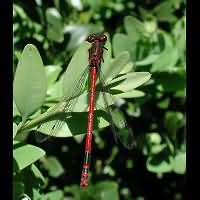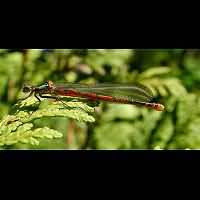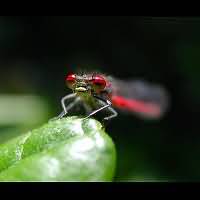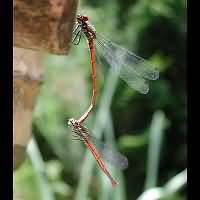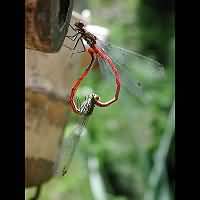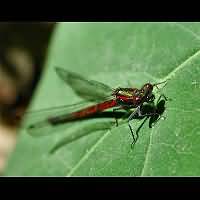[All pictures of garden wildlife on this page are thumbnails. Click on any thumbnail for a large format to be displayed.]
Large Red Damselfly (Pyrrhosoma nymphula)
The beautiful Large Red Damselfly can only be mistaken by the Small Red Damselfly, which has red legs, is smaller and appears later. The Large Red Damselfly's legs are black. Males have the entire abdomen red, except for the very last segments which have black markings on top. The females carry black markings on top of all segments of the abdomen. Even though it is called the Large Red Damselfly it is not very large, actually. The length usually is 36mm and the wingspan seldomly is over 45mm.
The eggs are laid in a tandem. Females are rarely seen laying the eggs by themselves. During the egg laying process males stand right over their females, only rarely clinging on to a waterplant. Females submerge regularly, males less frequently. The eggs are being deposited on waterplants, usually stems, one by one. During the first year, the larvae live among the waterplants. During the 2nd and 3rd year they usually stick to the bottom. The cycle may however also be completed in just one year, which almost never happens in the UK, or two years.
Adult Large Red Damselflies appear very early. In favourable springs, they may appear as early as the last week of March. They also disappear early, usually the last are seen around the longest day of the year. Despite the beautiful red colour, the animals are not easily seen, for they usually fly about in thick vegetation, often quite far from the waterfront. The Large Red Damselfly prefers small standing water, preferably with a rich vegetation, both in the water as on the waterfront. It is often the first species to colonize new pools and ponds, including those in everyday gardens. A common species all over Britain and Ireland, even seen near ponds in the centres of villages and cities.
The eggs are laid in a tandem. Females are rarely seen laying the eggs by themselves. During the egg laying process males stand right over their females, only rarely clinging on to a waterplant. Females submerge regularly, males less frequently. The eggs are being deposited on waterplants, usually stems, one by one. During the first year, the larvae live among the waterplants. During the 2nd and 3rd year they usually stick to the bottom. The cycle may however also be completed in just one year, which almost never happens in the UK, or two years.
Adult Large Red Damselflies appear very early. In favourable springs, they may appear as early as the last week of March. They also disappear early, usually the last are seen around the longest day of the year. Despite the beautiful red colour, the animals are not easily seen, for they usually fly about in thick vegetation, often quite far from the waterfront. The Large Red Damselfly prefers small standing water, preferably with a rich vegetation, both in the water as on the waterfront. It is often the first species to colonize new pools and ponds, including those in everyday gardens. A common species all over Britain and Ireland, even seen near ponds in the centres of villages and cities.

© Copyright 1998-2024 gardensafari.net (Hania Berdys)

 English / engels
English / engels  Dutch / nederlands
Dutch / nederlands